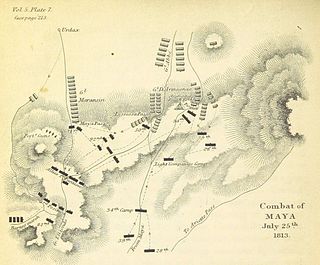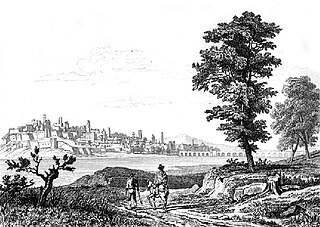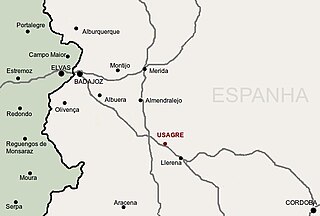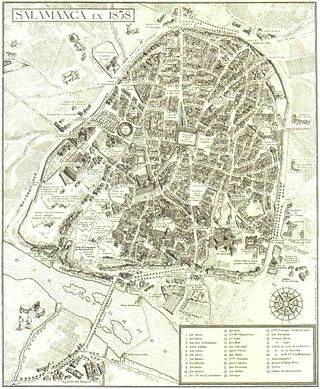
The Battle of Salamanca on 22 July 1812 was a battle in which an Anglo-Portuguese army under the Earl of Wellington defeated Marshal Auguste Marmont's French forces at Arapiles, south of Salamanca, Spain, during the Peninsular War. A Spanish division was also present but took no part in the battle.

The Battle of Albuera was a battle during the Peninsular War. A mixed British, Spanish and Portuguese corps engaged elements of the French Armée du Midi at the small Spanish village of Albuera, about 20 kilometres (12 mi) south of the frontier fortress-town of Badajoz, Spain.

The Battle of the Pyrenees was a large-scale offensive that was launched on 25 July 1813 by Marshal Nicolas Jean de Dieu Soult from the Pyrénées region on orders of Emperor Napoleon in the hope of relieving French garrisons under siege at Pamplona and San Sebastián. After initial success, the offensive ground to a halt in the face of increased allied resistance under the command of Arthur Wellesley, Marquess of Wellington. Soult abandoned the offensive on 30 July and headed toward France after he had failed to relieve either garrison.

The Battle of Orthez saw the Anglo-Spanish-Portuguese Army under Field Marshal Arthur Wellesley, Marquess of Wellington attack an Imperial French army led by Marshal Nicolas Soult in southern France. The outnumbered French repelled several Allied assaults on their right flank, but their center and left flank were overcome and Soult was compelled to retreat. At first the withdrawal was conducted in good order, but it eventually ended in a scramble for safety and many French soldiers became prisoners. The engagement occurred near the end of the Peninsular War.

In the First Battle of Porto the French under Marshal Soult defeated the Portuguese, under General Parreiras, outside the city of Porto during the Peninsular War. Soult followed up his success by storming the city.

The Battle of Maya saw an Imperial French corps led by Jean-Baptiste Drouet, Comte d'Erlon attack the British 2nd Division under William Stewart at the Maya Pass in the western Pyrenees. Despite being surprised, the outnumbered British soldiers fought stoutly, inflicting greater losses on the French than they suffered themselves. By the afternoon, the French gained the upper hand and were pressing forward, but the late arrival of a brigade from the British 7th Division stabilized the situation. The British forces slipped away under the cover of night and the French did not pursue effectively. The Peninsular War battle at Maya was part of the Battle of the Pyrenees, which ended in a significant Anglo-Allied victory.

The Battle of the Gebora was a battle of the Peninsular War between Spanish and French armies. It took place on 19 February 1811, northwest of Badajoz, Spain, where an outnumbered French force routed and nearly destroyed the Spanish Army of Extremadura.

Francisco López Ballesteros (1770–1833) was a Spanish general.

At the siege of Burgos, from 19 September to 21 October 1812, the Anglo-Portuguese Army led by General Arthur Wellesley, Marquess of Wellington tried to capture the castle of Burgos from its French garrison under the command of General of Brigade Jean-Louis Dubreton. The French repulsed every attempt to seize the fortress, resulting in Wellington's withdrawal. The siege took place during the Peninsular War, part of the Napoleonic Wars. Burgos is located about 210 kilometres (130 mi) north of Madrid.

In the Battle of Usagre on 25 May 1811, Anglo-Allied cavalry commanded by Major-General William Lumley routed a French cavalry force led by Major-General Marie Victor Latour-Maubourg at the village of Usagre, Spain, in the Peninsular War.

In the Battle of the Bidasoa on 7 October 1813 the Allied army of Arthur Wellesley, Marquess of Wellington wrested a foothold on French soil from Nicolas Soult's French army. The Allied troops overran the French lines behind the Bidassoa River on the coast and along the Pyrenees crest between the Bidasoa and La Rhune (Larrun). The nearest towns to the fighting are Irun on the lower Bidassoa and Bera on the middle Bidasoa. The battle occurred during the Peninsular War, part of the wider Napoleonic Wars.

In the Battle of Villagarcia on 11 April 1812, British cavalry commanded by Lieutenant-General Sir Stapleton Cotton routed a French cavalry force led by Général de Brigade Charles Lallemand at the village of Villagarcia in the Peninsular War. Cotton intended to trap the French cavalry, which was separated by a number of miles from the main body of the French army, by executing simultaneous frontal and flank attacks. The plan came close to disaster when the forces making the frontal assault pushed forward prematurely. The situation was saved by the timely arrival of John Le Marchant's force on the French left flank.

The Battle of Bayonne saw the French garrison of Bayonne led by General of Division Pierre Thouvenot launch a sortie against a besieging force of British, Portuguese, and Spanish troops commanded by Lieutenant General John Hope. The fighting marked the last major battle of the Peninsular War and occurred after unofficial news of Napoleon's 4 April abdication reached the opposing forces. Thouvenot's reasons for initiating the sortie are not clear because there was apparently nothing for the French to gain by fighting. After the French enjoyed initial success, Allied forces drove them back inside Bayonne with heavy losses on both sides.
The Battle of Garris or Battle of Saint-Palais saw an Allied force under the direct command of General Arthur Wellesley, Marquess Wellington attack General of Division Jean Harispe's French division. The French defenders were driven back into the town of Saint-Palais in confusion. Because of this minor victory, the Allies were able to secure a crossing over the Bidouze River during this clash from the final stages of the Peninsular War.

In the Battle of Campo Maior, or Campo Mayor, on 25 March 1811, Brigadier General Robert Ballard Long with a force of Anglo-Portuguese cavalry, the advance-guard of the army commanded by William Beresford, clashed with a French force commanded by General of Division Marie Victor de Fay, marquis de Latour-Maubourg. Initially successful, some of the Allied horsemen indulged in a reckless pursuit of the French. An erroneous report was given that they had been captured wholesale. In consequence, Beresford halted his forces and the French were able to escape and recover a convoy of artillery pieces.

In the Battle of Tordesillas, Battle of Villa Muriel or Battle of Palencia between 25 and 29 October 1812, a French army led by Joseph Souham pushed back an Anglo-Portuguese-Spanish army commanded by Arthur Wellesley, Marquess Wellington. After its failed Siege of Burgos, the 35,000-man Allied army withdrew to the west, pursued by Souham's 53,000 French soldiers. On 23 October, French cavalry attacked the Allied rear guard in the inconclusive Battle of Venta del Pozo. The Allies pulled back behind the Pisuerga and Carrión Rivers and took up a defensive position.

The second siege of Badajoz saw an Anglo-Portuguese Army, first led by William Carr Beresford and later commanded by Arthur Wellesley, the Viscount Wellington, besiege a French garrison under Armand Philippon at Badajoz, Spain. After failing to force a surrender, Wellington withdrew his army when the French mounted a successful relief effort by combining the armies of Marshals Nicolas Soult and Auguste Marmont. The action was fought during the Peninsular War, part of the Napoleonic Wars. Badajoz is located 6 kilometres (4 mi) from the Portuguese border on the Guadiana River in western Spain.
In the Battles of San Millán and Osma two divisions of the Allied army of Arthur Wellesley, Marquess of Wellington clashed with two divisions of King Joseph Bonaparte's Imperial French army in northeast Spain. "extremely punishing couple of miniature battles at Osma and San Millan which ruined Maucune's division and sent the Army of ... There were in fact two armies involved in the campaign of 1813 " "Contact was, however, inevitable and on 18 June there was a sharp fight at the small village of San Millan, when the Light ... The French tried to make a stand at Osma the same day, but this was effortlessly beaten back and with it went .."

The Battle of Arzobispo on 8 August 1809 saw two Imperial French corps commanded by Marshal Jean-de-Dieu Soult launch an assault crossing of the Tagus River against a Spanish force under José María de la Cueva, 14th Duke of Alburquerque. Alburquerque's troops rapidly retreated after suffering disproportionate losses, including 30 artillery pieces. El Puente del Arzobispo is located 36 kilometres (22 mi) southwest of Talavera de la Reina, Spain. The action occurred during the Peninsular War, part of a larger conflict known as the Napoleonic Wars.

The siege of the Salamanca forts saw an 800-man Imperial French garrison directed by Lieutenant Colonel Duchemin defend three fortified convents in the city of Salamanca against the 48,000-strong Allied army led by Arthur Wellesley, Lord Wellington. During this time, the French commander Marshal Auguste de Marmont led a 40,000-man French army in an unsuccessful attempt to relieve the garrison. An Allied failure to bring sufficient artillery ammunition caused the siege to be prolonged. The garrison repulsed a premature British attempt to storm the fortified convents on 23 June, but finally surrendered four days later after an artillery bombardment breached one fort and set another one on fire. During his maneuvering, Marmont formed the idea that Wellington was only willing to act on the defensive. This mistaken notion would contribute to Marmont's defeat at the Battle of Salamanca a month later.




















